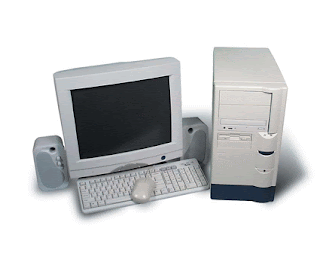A computer is, at its most basic, a machine which can take instructions, and perform computations based on those instructions.
Is the ability to take instructions and excecute them that differ a computer from a calculator.
- Microcomputer: is a computer that has a microprocessor chip as its CPU. They are often called personal computers because they are designed to be used by one person at a time. Personal computers are typically used at home, at school, or at a business. they come in two major varieties; desktops and laptop computers. Desktop computers are larger and not meant to be portable. They usually sit in one place. The computer holds the motherboard, drives, power supply, and expansion cards.
- Workstation/Servers: is a powerful, high-end microcomputer. They contain one or more microprocessor CPUs. They may be used by a single-user for applications requiring more power than a typical PC. workstation-class microcomputers may be used as server computers that supply files to client computers over a network.
- Minicomputers: is a multi-user computer that is less powerful than a mainframe. This class of computers became available in the 1960’s when large scale integrated circuits made it possible to build a computer much cheaper than the then existing mainframes.
- Mainframes: is a large, powerful computer that handles the processing for many users simultaneously (up to several hundred users). The name mainframe originated after minicomputers appeared in the 1960’s to distinguish the larger systems from the smaller minicomputers.Users connect to the mainframe using terminals and submit their tasks for processing by the mainframe. A terminal is a device that has a screen and keyboard for input and output, but it does not do its own processing (they are also called dumb terminals since they can’t process data on their own). The processing power of the mainframe is time-shared between all of the users.
- SuperComputers: is a mainframe computer that has been optimized for speed and processing power. The most famous series of supercomputers were designed by the company founded and named after Seymour Cray. The Cray-1 was built in the 1976 and installed at Los Alamos National Laboratory. Supercomputers are used for extremely calculation-intensive tasks such simulating nuclear bomb detonations, aerodynamic flows, and global weather patterns. A supercomputer typically costs several million dollars.
Personal computers come in two major varieties, desktop computers and laptop computers: | |||
Desktop computers are larger and not meant to be portable. They usually sit in one place. |










No hay comentarios:
Publicar un comentario